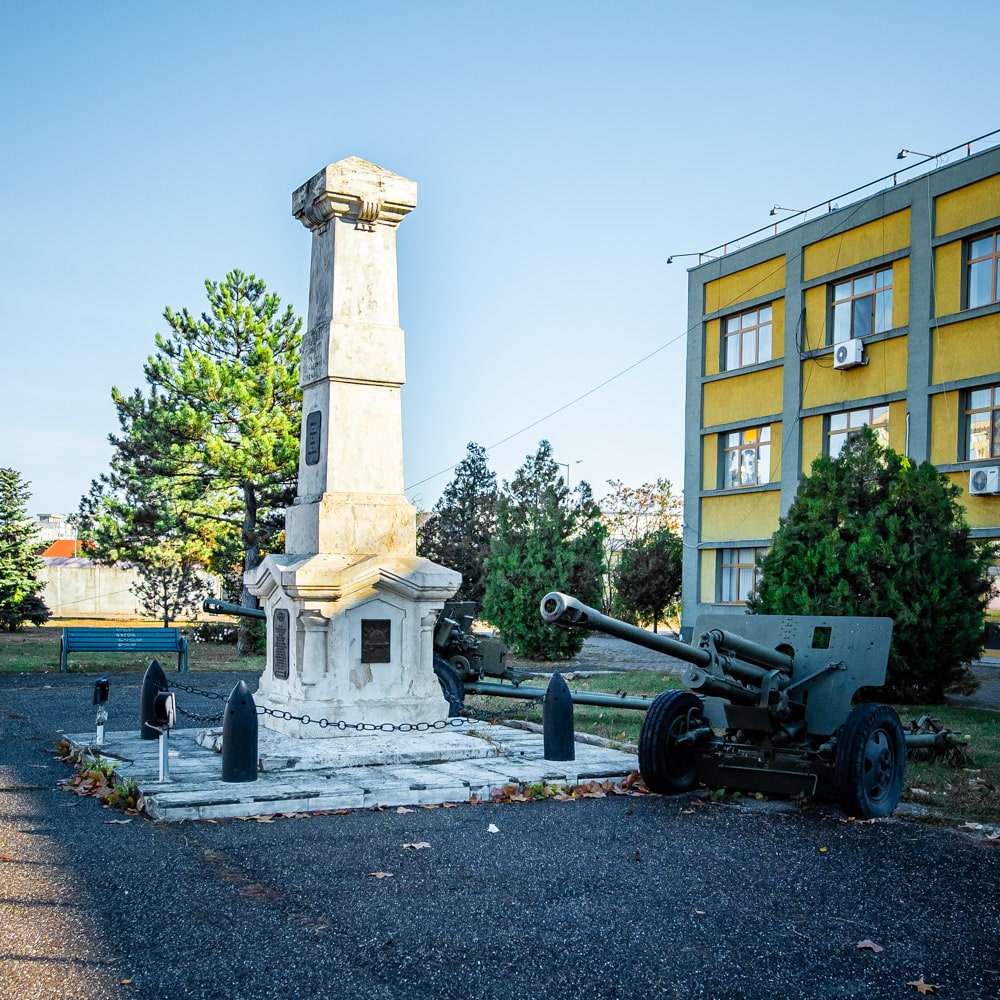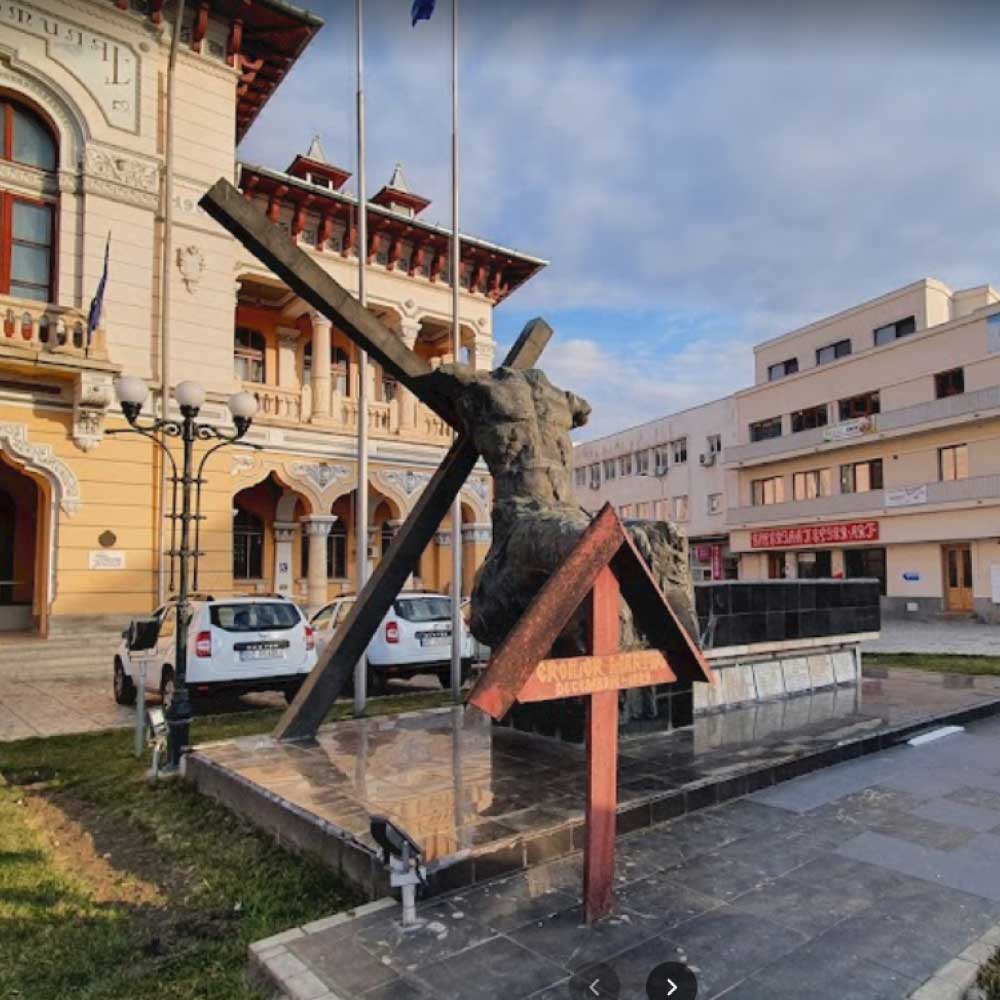
Bustul scriitorului Vasile Voiculescu
noiembrie 7, 2022
Monumentul Regimentului 48 Infanterie Buzău
noiembrie 7, 2022Română
MONUMENTUL REVOLUŢIEI DIN DECEMBRIE 1989 – BUZĂU
În decembrie 1989, revoluţia începută la Timişoara s-a extins şi la Bucureşti. Ma mulţi buzoieni au participat la evenimentele din zona Televiziunii Române, Academiei Militare, Aeroportului Otopeni. La Buzău demonstraţiile populare au început în ziua de 22 decembrie 1989, când manifestanţii au ocupat sediul Primăriei oraşului. În seara zilei de 23 decembrie 1989 au avut loc puternice schimburi de focuri în oraş, în special în partea de sud-vest şi în zona Pădurii Crâng, unde sunt situate unităţile militare şi era Comandamentul Armatei a 2-a. În evenimentele din decembrie 1989 au murit 47 de buzoieni, în oraş sau în alte localităţi din ţară. În anul 1990, artistul plastic Tudor Ioan Şerban a realizat un monument dedicat memoriei martirilor revoluţiei din Decembrie 1989, amplasat în faţa Palatului Comunal din Buzău. În concepţia artistului, monumentul reprezintă trupul fără cap şi fără picioare al unui tânăr, sprijinit pe firele reticulare ale unei arme. O altă interpretare, care a generat nemulţumiri din partea bisericii ortodoxe, este că cele două axe intersectate în spatele trupului tânărului ar reprezenta o cruce răsturantă, ceea ce ar aduce atingere simbolului creştinismului. Pe soclul statuii, placat cu marmură roşie, sunt înscrise numele celor 47 de martiri buzoieni, cărora li se aduce omagiul cu prilejul comemorării evenimentelor din Decembrie 1989.
English
THE MONUMENT OF THE REVOLUTION OF DECEMBER 1989 – BUZĂU
In December 1989, the revolution that began in Timișoara spread to Bucharest. Many people from Buzău took part in the events in the area of the Romanian Television, the Military Academy and Otopeni Airport. In Buzău, the popular protests began on 22nd December 1989, when protesters occupied the town hall. On the evening of 23rd December 1989 there were heavy exchanges of fire in the city, especially in the south-west and in the Crâng Forest area, where military units are located and where the Second Army Command was located. In the events of December 1989, 47 people of Buzău died, in the city or in other places in the country. In 1990, the artist Tudor Ioan Șerban created a monument dedicated to the memory of the martyrs of December 1989 revolution, placed in front of Buzău Communal Palace. In the artist’s conception, the monument represents the headless and legless body of a young man, leaning on the reticular threads of a weapon. Another interpretation, which has generated dissatisfaction from the Orthodox Church, is that the two intersecting axes behind the young man’s body would represent an inverted cross, which would be detrimental to the symbol of Christianity. On the statue’s red marble plinth are inscribed the names of the 47 martyrs of Buzău, to whom homage is paid on the occasion of the commemoration of the events of December 1989.
Francais
MONUMENT A LA REVOLUTION DE DECEMBRE 1989 – BUZĂU
En décembre 1989, la révolution qui a débuté à Timișoara s’est étendue à Bucarest. De nombreux habitants de Buzău ont participé aux manifestations organisées dans le quartier de la Télévision Roumaine, de l’Académie Militaire et de l’Aéroport d’Otopeni. A Buzău, les manifestations populaires ont commencé le 22 décembre 1989, lorsque des manifestants ont occupé l’Hôtel de Ville. Dans la soirée du 23 décembre 1989, il y a eu des échanges de tirs nourris dans la ville, notamment au sud-ouest et dans la zone de la Forêt de Crâng, où se trouvent des unités militaires et où se trouvait le Commandement de la 2e Armée. Au cours des événements de décembre 1989, 47 personnes originaires de Buzău sont mortes, dans la ville ou dans d’autres endroits du pays. En 1990, l’artiste Tudor Ioan Șerban a créé un monument dédié à la mémoire des martyrs de la révolution de Décembre 1989, placé devant le Palais Communal de Buzău. Dans la conception de l’artiste, le monument représente le corps sans tête et sans jambes d’un jeune homme, appuyé sur les fils réticulaires d’une arme. Une autre interprétation, qui a suscité le mécontentement de l’Église orthodoxe, est que les deux axes qui se croisent derrière le corps du jeune homme représenteraient une croix inversée, ce qui serait préjudiciable au symbole du christianisme. Sur le socle en marbre rouge de la statue sont inscrits les noms des 47 martyrs de Buzău, auxquels un hommage est rendu à l’occasion de la commémoration des événements de Décembre 1989.




